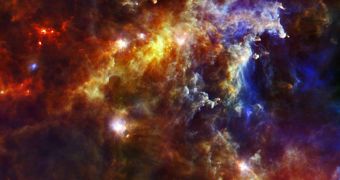Researchers at the European Space Agency (ESA) recently released one of the most amazing new images snapped by their Herschel Space Telescope. The instrument, which is the most advanced currently in orbit around Earth, managed to capture an impressive view of the Rosetta Nebula, a formation associated with a large mass of dust and gas, called the Rosetta Cloud. Together, the two structures have the ability to form tens of thousands of new, Sun-sized stars.
Thanks to the advanced observational capabilities Herschel has, astronomers were capable of discovering the existence of previously-unknown stars, located deep within the dust and glass clouds. These large fireballs are about ten times the mass of the Sun each, and some of them are still enveloped by their giant “cocoons.” The new photograph was released by OSHI the ESA Online Showcase of Herschel Images. The Rosetta Cloud is located approximately 5,000 light-years away from our solar system. The new observations are very important for understanding how this structure will evolve, the scientists behind the study say.
They add that the discovery of these new stars throws a new light on how the nebula will evolve and develop over the next millions of years. The massive protostars found to be still hiding in their dust and gas envelopes have the ability to stir the matter around them, via powerful solar winds. This in turn dictates the rate at which the nebula will produce new stars in the future, as well as the rate at which the new fireballs will appear.
“The massive stars powering the nebula lie to the right of the image but are invisible at these wavelengths. Each color represents a different temperature of dust, from –263ºC (only 10ºC above absolute zero) in the red emission to –233ºC in the blue. The bright smudges are dusty cocoons hiding massive protostars. These will eventually become stars containing around ten times the mass of the Sun. The small spots near the center and in the redder regions of the image are lower mass protostars, similar in mass to the Sun,” the ESA experts write on their official website.

 14 DAY TRIAL //
14 DAY TRIAL //